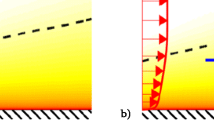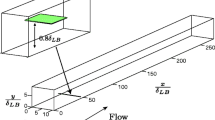Abstract
Experiments are performed to study the possibility of decreasing the net drag of a flat plate with the use of streamwise-oriented vertical elements mounted normal to the surface in an incompressible equilibrium turbulent boundary layer. The Reynolds number based on the boundary-layer momentum thickness in the section where the vertical elements are placed is 820. It is demonstrated that vertical large eddy breakup elements with the geometry used do not reduce the drag of a flat plate in the major part of the range of Reynolds numbers Re x examined. It is only at extremely low values of Re x that a certain gain in the net drag is reached, as compared with the value for a non-modified flow.
Similar content being viewed by others
References
E. Coustols and A.M. Savill, Turbulent skin-friction drag reduction by active and passive means, Paper Reprinted from AGARD Report 786, Pts 1 and 2, 1992, P. 8-1–8-80.
A.V. Boiko and V.I. Kornilov, On the vertical large eddy breakup device capability to decrease the turbulent drag, Thermophysics and Aeromechanics, 2009, Vol. 16, No. 4, P. 549–560.
V.I. Kornilov, Reduction of turbulent friction by active and passive methods (review), Thermophysics and Aeromechanics, 2005, Vol. 12, No. 2, P. 175–196.
V.I. Kornilov, Direct measurements of the drag of a body of revolution in an incompressible flow under the action of eddy breakup devices, Thermophysics and Aeromechanics, 2006, Vol. 13, No. 4, P. 499–506.
J.M.H. Wallace, H. Eckelmann, and R.S. Brodkey, The wall region in turbulent shear flow, J. Fluid. Mech., 1972, Vol. 54, P. 39–48.
V.I. Borodulin, Y.S. Kachanov, and A.P. Roschektayev, Investigation of LEBU-device effect on turbulent boundary layer structure by means of ‘deterministic turbulence method’, in: Proc. XIV Int. Conf. on the Methods Aerophys. Research, June 30–July 6, 2008, Novosibirsk, ITAM SB RAS, CD Section 2.
N. Hutchins and K.-S. Choi, The use of sub-boundary layer flow-aligned vertical elements to achieve turbulent skin friction reduction, in: Proc. 12th European Drag Reduction Meeting, Denmark, 2002.
I. Lee, A.N. Hyun, and H.H. Chun, Assessment of drag reducing efficiency of outer-layer vertical blades, in: Proc. 12th Asian Congress of Fluid Mechanics, 18–21 August, 2008, Daejeon, Korea, P. 1/4–4/4.
T. Cebeci, An Engineering Approach to the Calculation of Aerodynamic Flows, Springer-Verlag, Berlin, 1999.
Author information
Authors and Affiliations
Corresponding author
Rights and permissions
About this article
Cite this article
Kornilov, V.I. Effect of vertical large eddy breakup devices on the drag of a flat plate. Thermophys. Aeromech. 17, 249–258 (2010). https://doi.org/10.1134/S0869864310020101
Received:
Published:
Issue Date:
DOI: https://doi.org/10.1134/S0869864310020101




